This section contains entries about our botanizing in Baja California written for the UC BEE (Oct 2012 to Aug 2021)
and The UC Hive (2022-), monthly newsletters for volunteers and staff of the UC Berkeley Botanical Garden.
Click on any photo for a larger image.
BEE MARCH 2014
Spiders — Flowers — Liverworts — Mushrooms — Goats — Figs
Even though the summer was wet and the greenery has lasted many months, we are finally drying up. It's a time when many perennials and trees are losing the last of their leaves and either entering a dormant state or getting ready to burst forth in flower, and most annuals from late last year are still dispersing their seeds. By the time this is published, we could be seeing some signs of spring from the Palo Verde (Parkinsonia microphylla) and Mesquite (Prosopis glandulosa var. torreyana). I'm not looking forward to the mango and date blooms though, a time of severe allergies for many of us. This a good time to catch up on some of the images from late last year and early this year so you will find a mixed bag below.
November 2013

Aiiiiiy!!! Space invaders! Run for your lives! This is a silver garden orbweaver spider, Argiope argentata. They are common in Baja California in the Fall. Webs are usually around knee to thigh height.
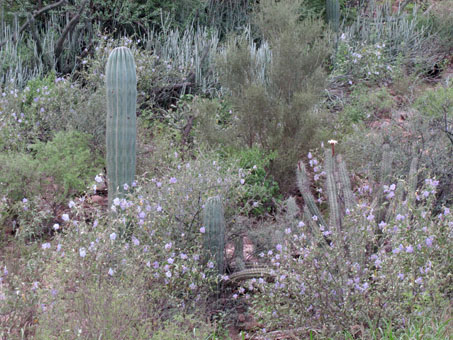
Up on a hillside out in the valley. The hills were alive with the lavender flowers of Mariola (Solanum hindsianum, Solanaceae).

The body and legs are silvery gray. The abdomen is knobby with several golden-yellow bars on the upper surface. The underside is mostly black with some yellow markings. This is the larger female, leg span is 4-5 cm, the body about 1 cm.
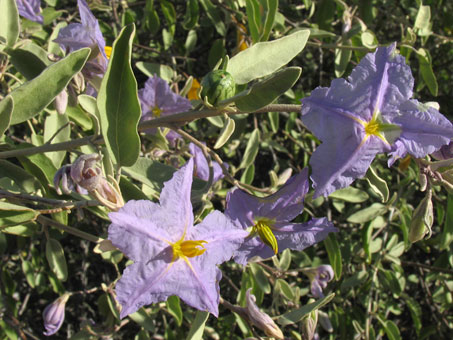
Flowers and fruit of Mariola (Solanum hindsianum). Leaves are densely hairy and velvety. Flowers are 2.5-5 cm D & may be very pale to deep lavender. Branches have sparse, sharp spines.
When it was still incredibly green, there were lots of wet places in shady areas, both around the river and in the desert washes out in the Mulege valley, where liverworts and fungi were abundant. When I returned a few weeks later to recheck the liverworts, they had already curled up and gone dormant.
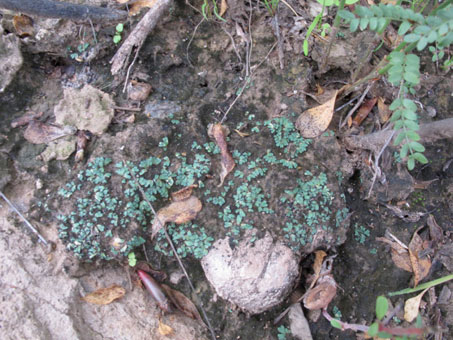
An unknown species of a thalloid liverwort I came across in a damp, shady area on a rocky hillside in the valley.
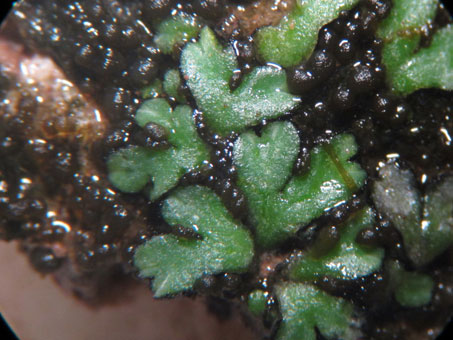
First time I've seen this species here. Closeup of the unknown liverwort in a bed of what is probably a black soil lichen.
In many places in loose, dry soils in the valley, the desert shaggy mane fungi (Podaxis pistillaris) were abundant. This mushroom grows worldwide in desert areas, including the southwestern United States, dry leeward sides of some Hawaiian islands, Africa, the Middle East, South Asia and Australia. It is related to puffballs. This inedible fungi stands about 10-15 cm tall. The cap is dry and may split, before it eventually falls off, leaving the dry, hard, almost woody stalk behind. A detailed description can be found at the excellent Fungi of California site. They grow singly or in groups. One patch I saw had 11 caps in about 1 sq. meter.
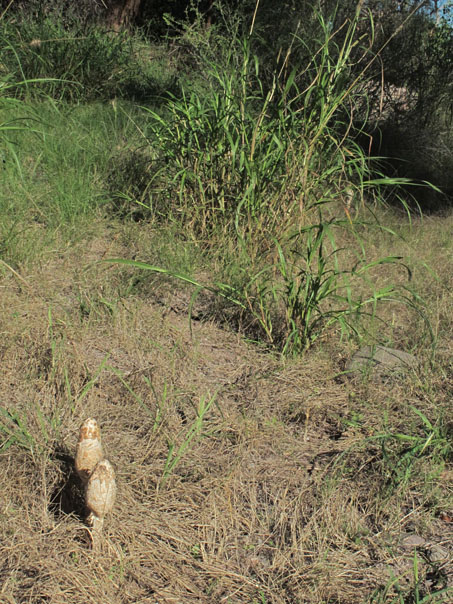 Podaxis pistillaris, desert shaggy mane.
Podaxis pistillaris, desert shaggy mane.
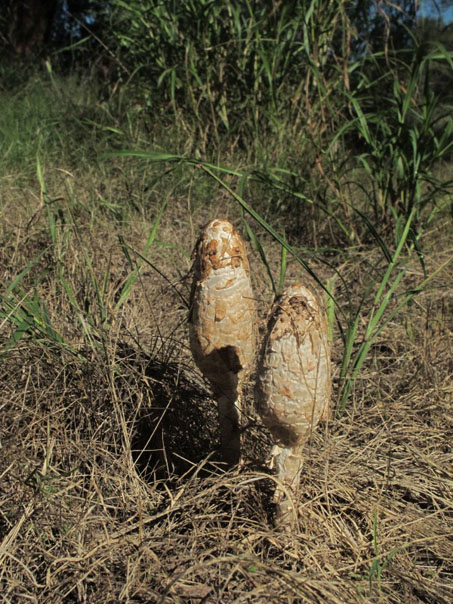 Podaxis pistillaris, desert shaggy mane.
Podaxis pistillaris, desert shaggy mane.
Early in our stay, I also met some of the culprits who keep eating the plants I am trying to study. They are kind of cute, and (close your eyes vegetarians) quite tasty as the main ingredient of a traditional mexican stew called birria. If they would just decimate the invasive Bufel Grass (Pennisetum ciliare) and Bermuda Grass (Cynodon dactylon), I might not hold such a grudge. They don't compact the soils quite as much as cattle though they do damage delicate annuals. However, unlike cattle, they will eat almost any plant to the nub, except for the less palatable grasses mentioned above, which they will ignore as long as there happens to be some nice native species I am interested in nearby.

Got a problem?
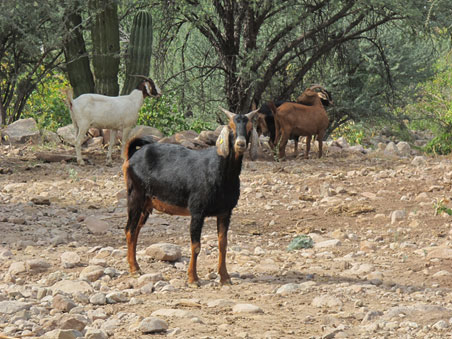
Cute but destructive beasts. Their milk, made into cheese and a number of other products such as requesón (similar to ricotta cheese), chongos (candied curds) and cajeta (caramel sauce), and their meat are important in the economy of local ranches.
December 2013
A couple of years ago, I came across what looked to be a single wild fig tree (Ficus palmeri) known locally as Zalate or Higuera cimarrón that was growing on top of a rocky outcrop high above a large arroyo near town. These trees are common in the mountains to the west of Mulegé and throughout the mountain ranges in Baja California Sur and the southern part of the state of Baja California. They are a plant to behold, their roots seemingly fused with the rock of steep cliffs. We saw a number on Isla Coyote (Feb 2014 issue), but they aren't very common, or are at least not very visible on the hills close to Mulegé.
I needed a specimen for my checklist, and a friend generously offered to climb the steep outcrop to get me the needed plant clippings. So, in early December, we took a nice, easy hike to the outcrop, via a new route that our friend introduced us to. It was an interesting trail and I was able to see a number of species on the hillsides that, up until that time, I had almost entirely seen only on the floor of various arroyos. I am slowly compiling more habitat data for the area´s plants, in this case, two more species that I now know are most common on, or even restricted to, both hillsides and arroyo bottoms. It seems that the common factor is likely well-drained, or fast-draining, soils.
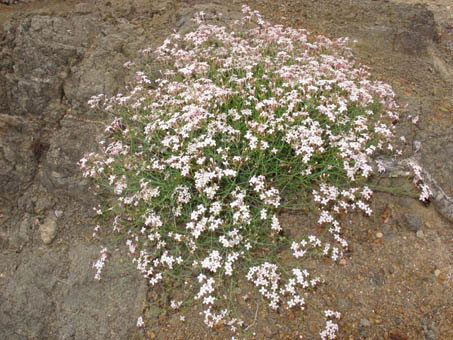
Baja California Star-violet (Stenotis brevipes, Rubiaceae). This genus is endemic to the peninsula. It occurs from southernmost Baja California and southward throughout Baja California Sur.

Heliopsis parviflora var. rubra (Asteraceae). This is an endemic species found in shady canyons and on rock faces in BC and BCS.

The wild fig or zalate (Ficus palmeri, Moraceae) as seen in 2010. It was the only one we could see at the time. However, on this trip, we were able to locate at least 5 more on adjacent outcrops.
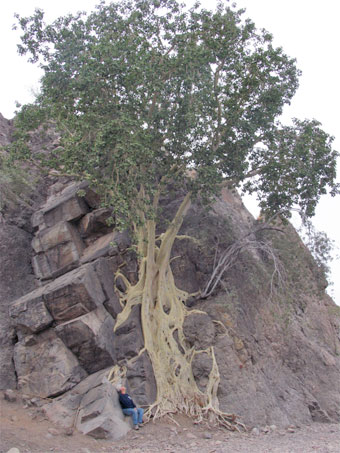 Just for comparison, this is a Zalate in the Sierra la Giganta, where the trees are common and huge.
Just for comparison, this is a Zalate in the Sierra la Giganta, where the trees are common and huge.
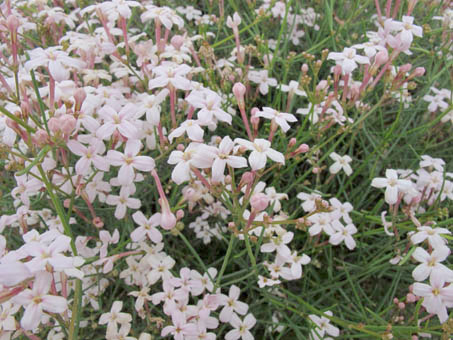
Baja California Star-violet (Stenotis brevipes, Rubiaceae). Found both on hillsides near the coast as well as sandy arroyos. I think the flowers smell a little like bubble gum.
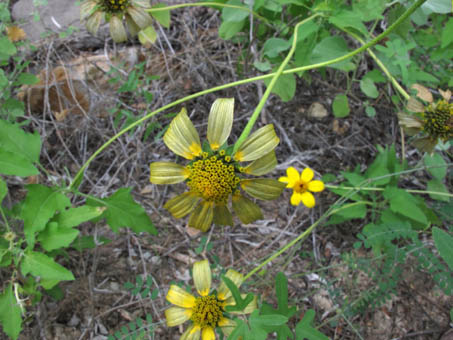
With age, the rays of Heliopsis parviflora var. rubra turn first green, then tan and papery and persist on the plant for months. The small disk flowers start out a deep maroon and as they open, show their yellow lobes.
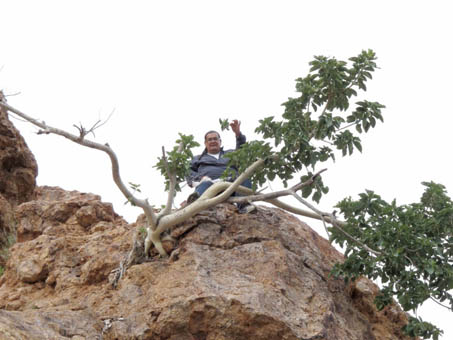
Got it! Specimens of Ficus palmeri (Moraceae). ¡Gracias Raffita!
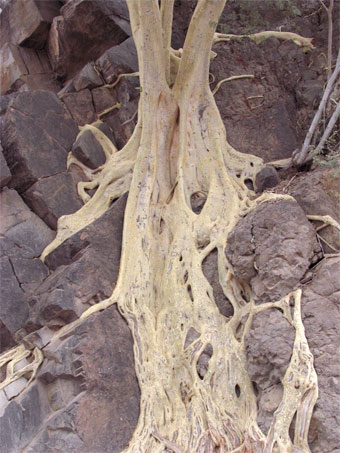 The roots are fused with the rock face and penetrate the surface via fissures, which they then fill and eventually enlarge.
The roots are fused with the rock face and penetrate the surface via fissures, which they then fill and eventually enlarge.
That's it for this entry. Next time, I'll take a look at the Santuario de los Cactos, near La Paz, that we visited in late January. There's an amazing number of huge columnar cacti in a remnant section of the Cape Region's arid tropical forest that is being protected from livestock damage. Hasta pronto!
Debra Valov—Curatorial Volunteer



















